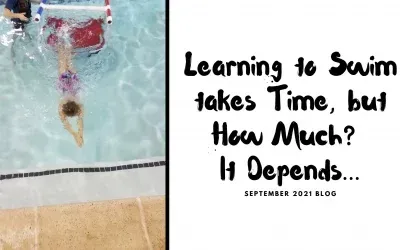Learning to Swim takes Time, but How Much? It Depends…

How long will it take my child to learn to swim? We get this question so much at the Front Desk and the answer is so nuanced and based on the individual child and his needs. But, I will attempt to answer it here…hopefully, lol. This might be a bit of a long one, so, in the words of Samuel L. Jackson in Jurassic Park, hold onto your butts! haha!
When a parent asks me when his child will be able to swim, the absolute first questions I ask back is what is your definition of swimming and what are your goals. When I (personally) think of “swimming,” I think of a person who can swim at least 1 length of the pool freestyle with side breathing and a propulsive kick, like a baby Micheal Phelps. (I then imagine a 3-year-old swimming like this and it makes me giggle, but I digress). However, many times parents reply that their definition of swimming is being safe in the water without them having to watch the child. Then I laugh and tell them it’ll be a few years before that happens. Other parents are more realistic and say that they want their child to be able to paddle a few strokes and “swim” 2-3 feet, and depending on the age and ability of the child, this is totally feasible within 2-3 sessions.
So let’s look at our levels and our goals. Level 1 is all about comfort, then mobility. You will not be able to swim in the water without being comfortable and being able to float. So much of Level 1 is centered around comfortability (playing games, doing crocodiles and bunny hops, practicing jumps) and floating. Every single one of my level 1 classes float on their front and back at least twice per lesson because it’s that important! (Even the first few weeks of all our lessons center around the basics of swimming, including floating and breath control). So while Level 1 may not look like we are doing all that much, we are building the foundation of all the levels and all the skills.
It’s not until a child can submerge themselves underwater that they will be able to swim, and this doesn’t happen until the end of Level 1 (Orange) and Level 2. Once a child can float with their face in the water, they will be able to begin paddling around and “swimming.” From there we start learning how to do “big arms” or “alternated arm and switch.” You’ll definitely see my Level 2 classes kicking with 1 hand up and 1 hand down because we are practicing not only our propulsive kick but a full stroke from hip to above the head. This goes beyond the doggy paddling that some parents might be referring to when they want their child to “swim.”
Finally, in Level 3, we are working on perfecting our freestyle, including the side breathing component, as well as our backstroke. However, in levels 1-3, all the focus is on perfect short distances. That is why you will not see very many of our kids doing full laps repetitively. It’s not until the end of Level 3 (Blue) and Level 4 (Blue/Purple and Purple) that we get to my definition of swimming (a full-length freestyle with side breathing and propulsive kick).
And just to complete the goals of our levels, Level 4 & 5 is all about building the distance on freestyle and backstroke and coordinating breaststroke and butterfly.
Once I have established what the parent is looking for in terms of swimming ability, then I look at the individual child. Is the child afraid of the water? Does the kid mind getting splashed in the face? Will the child go underwater happily? If the child is afraid of the water, we are starting at the beginning of our levels, at Red, and depending on how afraid the child is, it might take a while for her to get comfortable and start dipping her face, then submerging herself. Getting a child who is afraid of the water to start going underwater could take up to a year (or more!). If the child doesn’t mind getting splashed in the face, but maybe isn’t dipping his face in the water yet, we would place him in a Red/Orange class. Now we are working still on comfortability, but there’s already some comfort there, and working on dipping the face for longer and longer periods, up to about 5-6 seconds. If the child is happily going underwater, then they are already at Level 2 (depending on age), and it makes our job so much easier! Now, we are just building those floating, kicking, and arm stroking skills. And, this is all for a neurotypical kid. If your child needs special accommodations or is on the spectrum, it could take longer.
“But my child’s been doggy-paddling around all summer–why can’t he do that here?” We get this question a lot too, and it goes back to comfortability and floating. Yes, your child might be able to swim with his head above the water, and he might be really good at it too, but this type of swimming is exhausting! Will your child be able to do this if he falls or is pushed in the water and his face gets wet? Will he be able to do it if he gets splashed? What happens when he gets tired? Swimming with your face out of the water doesn’t equate to comfort in the water. These are all safety concerns, and it’s why we focus on submersion, then mobility.
While this method of learning to swim takes time, we believe in our process. We believe in it so much, we offer a guarantee to all our students, ages 4+, that if they spend more than 3 sessions at a specific level, they get the 4th session for free! So parents, trust us! We know this way takes time, but so does learning how to figure skate, do karate, or play basketball. You wouldn’t expect your child to do triple axels, go up a few belts in karate, or make a layup in a few short months, and we cannot expect a 4-year-old to move along the top of the water long enough or far enough to get out of trouble in this short amount of time either.
So what can parents do? Practice, practice, practice! Tub time is the best time for trying skills out, like dipping faces in the water and even floating (depending on the size of your child and tub). I can totally remember trying to float in my bathtub when I was little. I can also remember trying to swim and making a mess, lol. Tub time is also great for practicing with goggles. A lot of kids will try more skills with goggles on (it’s like Dumbo’s magic feather). And also, we have our Free Friday Family Swims from 1-230 and 630-8 pm, where the entire immediate family can come swim for free! So everyone (yes, even you, Dad), can practice floating and goof around. You can have your child show you their tricks, and you can even show your kid some of your own.
The post Learning to Swim takes Time, but How Much? It Depends… appeared first on Swim-in Zone Swimming Academy.



